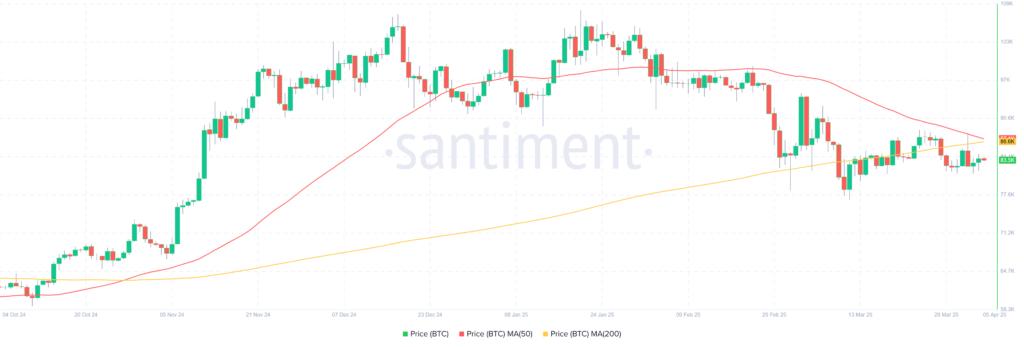Bitcoin prices have been trading in a volatile range ever since global financial markets have seen instability.
Analyst Ali Martinez via X points to a key resistance cluster at $87,000 as part of the technical difficulty that Bitcoin ($BTC) is now facing.
The convergence of three crucial technical indicators—the 200-day moving average, the 50-day moving average (MA), and the declining trendline from Bitcoin’s all-time high—makes this resistance level especially significant.

At the press time, Bitcoin is trading at $83,550.68, down 0.79% as compared to the same time last day.
Bitcoin’s Current Indicators Show Important Resistance Level
Since they aid in identifying both short- and long-term trends, traders pay special attention to the 50- and 200-day moving averages. A significant turning point in the price movement is frequently indicated when these MAs converge.
In this instance, the price of Bitcoin is in conflict at this crucial level, where it may either break through or see a sharp decline.
Despite The Current Fall, Market Participants Cheer Bitcoin’s Trajectory
Despite Bitcoin’s current fall, most market participants have cheered for Bitcoin given that it has still sustained better trading as compared to other financial assets.
Following the most recent intensification of the ongoing tariff war between major economies, stock markets around the world have seen sharp drops.
Concerns over possible interruptions in international trade that could impact global supply chains and corporate profits have been raised by the application of additional tariffs.
Fears that higher trade tensions may result in slower economic growth and higher company costs are causing investors to respond. Global trade-dependent businesses have been particularly heavily impacted, with markets in Europe, Asia, and the US all experiencing steep declines.
Despite this, Bitcoin has still traded over its $80K mark, giving many hope that the OG-crypto is truly a hedge against inflation.
Also Read: Michael Saylor Claims No Tariffs on Bitcoin, Hints at Buying Opportunity
How Does The Tariff War Impact Bitcoin?
The price of Bitcoin has been indirectly impacted by the economic uncertainty brought on by the United States’ tariffs, particularly those imposed on goods or commerce from other countries.
Inflation, disruptions in the supply chain, and shifts in the dynamics of global trade can all result from tariffs, which may lead investors to seek out safe-haven assets.
When conventional markets are erratic, Bitcoin usually gains value because it is seen as a hedge against inflation and economic uncertainty.
The broader consequences, however, can vary; some investors might sell assets to make up for losses in traditional markets affected by tariffs, while others might view Bitcoin as a safe haven for money during uncertain times.
At present, Bitcoin may start a new surge if it can overcome the $87,000 resistance mark. The price might have a correction or consolidation before any additional upward potential, though, if it is unable to break through.


